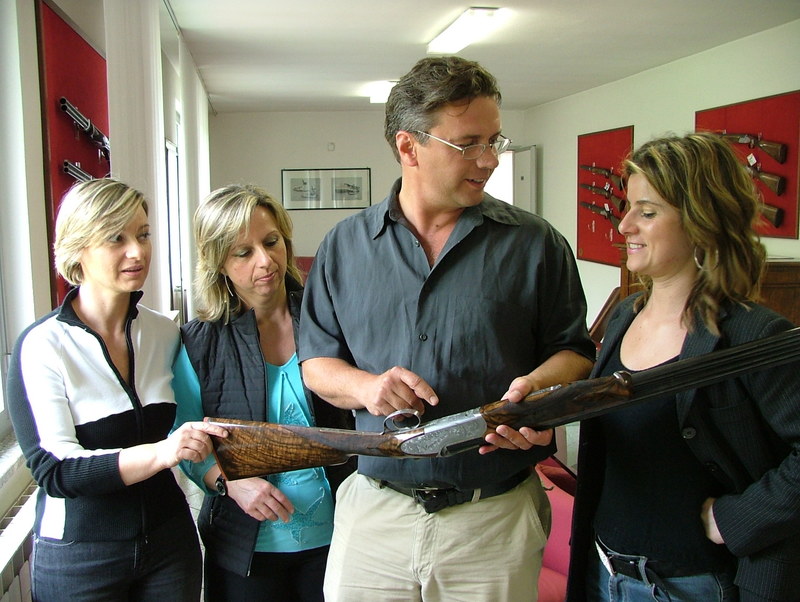
An American Engraver in
originally published in "SHOOTING SPORTSMAN" Nov/Dec 2006-photos and text copyright 2004 by
BARRY LEE HANDS
As an engraver, I’ve long been fascinated by the different styles of the art. At
every opportunity I study the ornamental designs and techniques of those who
came before me. From my studies in the 1970s under Ethan Jacczak at Gist
Engravers on the West Coast, and in the 1980s under Steve Huff and Dan Goodwin
in Montana, to my work with the Colt and Winchester custom shops and my recent
studies under Ron Smith and Winston Churchill, I have learned a deep respect for
the style of Old World engravers.
So how could I resist when, at the 2004 EWA show in
Only a month later I arrived at the Hotel Albergo Marcheno, with my duffel bag,
camera and laptop computer. My plan was to meet, interview and observe as many
craftsmen as possible in the short time I had.

I had no more than checked into my room and thrown my bags on the bed when I
headed down Via Independenza toward the town’s gunmaking center. I had walked
only 200 yards when I came upon the gunmaking firm of Fausti Stefano (see “The
Shotguns of Fausti Stefano,” Sept/Oct). The company is unusual in the trade in
that it is operated by founder Stefano Fausti’s three daughters: Elena, Giovanna
and Barbara. When I ducked into the building I met Barbara, who showed me the
company’s product line and offered to take me to the Giovanelli engraving school
in the morning.
The following day I met Barbara and we drove up the hill to Bottega Incisioni C.
Giovanelli. There I was greeted by interpreter Elena Micheli and Cesare
Giovanelli, the founder of the school. Elena does a lot of work as liaison
between American and Italian gunmakers and engravers. I was then introduced to
master engraver Dario Cortini, who showed me around the engraving room. I met
Mary Giovanelli, an Engraver and daughter of the founder, and students Tiziana
Rinaldini, Tiziano Baresi and Fabio Pasotti. Most of the students are from
.
The master and students were interacting in a very creative environment. Some
students were working on bulino figures, learning the classic Italian technique
that results in such stunning photographic realism and unparalleled beauty. The
bulino style is named after the tool that is used to execute it—a small, sharp
V-shaped chisel that fits in the palm. Tiny cuts the sizes of pinpoints are
made. Under high magnification, each cut by a master is often in the outline of
a small diamond or rhombus when viewed on the steel. A beginner, lacking the
skills to cut a proper rhombus, usually will cut one with a long tail. Students
must practice long hours to sharpen and use the tools properly to achieve the
proper cuts. Cuts are arranged in various densities to achieve a grey scale,
such as an artist in charcoal or pencil would use, and when all of the cuts are
in the right places, a very realistic image results.
Other students were practicing scrollwork . The quality of the work produced was
very high, considering that they were there to learn and improve.
Bottega Incisioni C. Giovanelli supplies
engraving to Beretta, Benelli, Perazzi, Guerini, Zoli and many others.
I had made an appointment at G.S. Pedretti Incisori.
The fine work here is done by the father-and-son team of Giancarlo and
Stefano, assisted by their other engravers Domenico and Simone . Stefano was
just finishing the Piotti gun he had shown me in
I then went around the corner and up the stairs to Creative Arts, to visit
Giacomo Fausti , Giovanni Steduto,and Ugo Talenti. The shop was obviously very
busy, turning out its usual excellent work. . Giacomo suggested that we visit
Ivano Tanfoglio at the Ferlib factory, so we crossed the river and headed up the
hill. Upon reaching a gate we rang the buzzer and walked up to the shop. We
entered and found three men working at the bench, a large black dog lying in the
corner, and Ivano in the back machine room busy at the lathe. We knew each other
from many meetings at the SCI Convention and other shows. Everyone was in good
spirits, laughing and grinning. Giacomo headed back to Creative Arts, and Ivano
showed me the product line and the production facility. Ferlib has since become
Rizzini Tanfoglio.
After we had seen some of everything, Ivano said that he had to visit his
actioner, so we jumped in his car with the dog and headed to up a winding road
to Alta Trompia.
The actioner’s shop was tiny but
very busy, and as Ivano discussed a job with the foreman, I watched the actioner
at the bench work at a furious pace. I had observed this type of work in many
shops and was impressed with this fellow, who obviously knew what he was doing.
After being taken upstairs to see the cheeses and sausages hanging in the wine
room, we headed down the hill and agreed to meet the next morning and return to
Ferlib.
In the morning Ivano picked me up, and we headed to Ferlib, where I met company
engraver Frederique Lepinois. Frederique was engraving a sidelock gun with her
own style, which I’ll call “lepinois.”
The layout had taken her a week, and the work was being done entirely in
bulino. It had taken her three weeks to complete most of the fantastic engraving
on the bottom of the action.
Frederique had many books in her library, among the more familiar to me being
Il Grande Libro delle Incisioni, by
Marco E. Nobili, and Florid Victorian
Ornament, by Karl Klimsch. She also had a set of books by L’Aventurine Press
covering architecture and iron ornament.
After Frederique finished one section, she applied chalk to the next as a base to draw through. After establishing her initial pattern, she went over it with a scribe so she could then remove the chalk and begin to engrave using the small bulino. Frederique is truly an excellent engraver.
.
Later that afternoon we drove to the workshop of Lionello Sabatti, who had with
him his friend Alfredo Bregoli. Alfredo and I had met while he was demonstrating
engraving for Steve Lamboy’s Ithaca Classic Doubles at one of the SCI shows. At
the time I was doing some consulting and training of engravers for
The next day I walked back up to Ferlib, where I watched Ivano file fences for
an hour before we headed to the workshop of Manrico Torcoli. When I saw
Manrico’s workroom, I was amazed at how neat and clean it was and how few tools
it held. There was a ball vise, two sharpening stones and three gravers. That
was it. The room otherwise was filled with books on wildlife and copies of
National Geographic. We stayed for a
bit, and Ivano translated as we discussed engraving, engravers and different
styles of work. Manrico showed me his portfolios, which contained many fine
examples of his work. He is the engraver who invented the style known as
“fantasy”—animals blended into lovely nude figures surrounded and mixed with
art nouveau motifs. He is one of the
rare modern engravers who has developed a style that he truly can call his own.
All one has to do is to look through the catalogs of major Italian firearms
makers to see the many attempts to imitate Manrico’s style.
On the bench was one piece, unmistakably his, decorated in a slightly more conventional manor. It contained upland birds and ornamentation but still using the bulino technique. Manrico said he would rather do pure fantasy work, but apparently even he has to follow the whims and wishes of clients to some extent. Much of his work is for Fabbri and F.lli Rizzini.
.
Manrico suggested we visit Gianfranco Pedersoli later in the day, and we went to
lunch at a restaurant in Alta Trompia .
After lunch we jumped in the car and headed off to visit the Pedersolis. We rang the bell, were buzzed in and were greeted by the master and his wife. Their home was very inviting and contained many works of art. The walls were covered with framed prints of rubbings taken from Gianfranco’s work. We were ushered into the studio, and I was impressed with the elegant but simple decoration and layout of the room. Gianfranco demonstrated his techniques at the bench, engraving with a bulino tool so quickly that it sounded like he was using a machine. He then demonstrated how he pulls a print, by rubbing ink into the engraving and burnishing a piece of damp paper into the impressions left by the tool. Once the paper is removed, it contains a very nice image of the work. I think Gianfranco’s work, which includes fantastic figures and scenes often surrounded by ornamentation with a baroque feel, influenced many of the region’s younger engravers a great deal. He also does a lot of work for Fabbri and F.lli Rizzini, as well as Tony Galazan in the States.
.
The next day I walked up to Ferlib, and Ivano mentioned that he had several appointments that morning. I told him not to worry about me, that I would come back in the afternoon. There were only two more artists who I felt I needed to meet: Firmo and Francesca Fracassi.
I walked down the valley toward
Firmo Fracassi answered the door,
invited me inside and introduced me to his wife
and his smiling daughter, Francesca, a charming young lady who,
fortunately for me, speaks some English. I offered my card and explained that I
was visiting from the
While Mrs. Fracassi went back to
preparing lunch in the kitchen, Firmo motioned us upstairs to the studio. The
bench was typical of what I was becoming familiar with as the Italian bulino
engravers: very neat and clean, set below a north-facing window in a tastefully
decorated room with art on the walls and many wildlife books on the shelves. The
exception this time was that there were two engraving balls in addition to the
usual two or three gravers and a couple of sharpening stones. Firmo sat at the
bench while Francesca sat beside him and acted as interpreter.
I was intrigued looking at the vises, because each piece of work had a small
cardstock cover over it with a 5/8” x 3/4” opening through which a small area
could be worked on. I asked Francesca about this. “We use the protection of the
card to avoid scratching the areas we are not working on at the moment,” she
said. She took off one of the covers, and I could see the mostly finished scene,
with swans and water and mountains in the distance. It was stunningly well done.
Even in its unfinished state, it gave the illusion of depth and sweep of scope
that only a true master of bulino can achieve.
Next I asked if they used any transfers or other mechanical or photo techniques
to put the initial designs on the metal, as is so often done in
The most striking things I noticed were the tiny parallel lines used in the sky
and water; they were almost straight, with the occasional bump or flutter to
indicate movement. They were very tiny and well cut, with no traces of the edges
or burrs that I typically see on even the best-cut lines. And the bulino’s tiny
nicks, so small as to appear to be dots, were always laid out in the direction
of flow in the scene, with not a single mark out of place.
Wondering how the cutting was accomplished so cleanly, I asked if there was any
polishing done after the work to remove burrs or roughness. In the
I said to Francesca, “Tell your father that I am very impressed with his work.”
She looked embarrassed and said, “This is
my work.” Now I felt a little stupid as she handed me another piece of work.
“This is my father’s,” she said with a smile. I took the loupe and examined this
piece, and I could see no discernable stylistic or technical differences with
the way the piece was executed. I am not sure, even today, if I’d be able to
tell whose work was whose unless I was looking at a piece I was familiar with.
I asked Francesca if there were any differences between her work and her
father’s, and after conferring with him she said, “My father has taught me to
engrave in his own way.” She did say that when the two work together on a piece
with bulino ornamentation in their own almost-art-nouveau
style, she often does the ornamentation while her father does the figures.
Mrs. Fracassi called us down for lunch, and we enjoyed a lovely meal of pasta
with bread and wine followed by cheeses, espresso and a liqueur. During the
meal, Firmo asked me many questions about my travels, the engraving business in
the
After lunch we returned to the studio, where I looked at dozens of photos, and Francesca picked out some for me to take. After saying goodbyes and being walked to the street, I headed back to Ferlib, my head spinning with their graciousness, their art and new ideas.
I thought it would be difficult to leave the small mountain city where so many
of the best guns are made and engraved, but I reflected on what I had learned.
These men and women as a whole had no secret techniques—no “tricks.” The methods
they used were very similar to what I had seen many other engravers practice. If
anything, their tools were simpler than those often used in the
As I walked back up Via Independenza, a blur of images and ideas raced through
my mind, and for the first time I felt ready to leave. I also was sure what I
needed to do next: I must get back to my
bench . . . .
Editor's note: Barry Lee
Hands, of Bigfork, Montana, has been a professional engraver for almost 30
years. His clients have included The
PULLQUOTE:
These men and women as a whole had no secret techniques—no ‘tricks.’